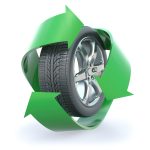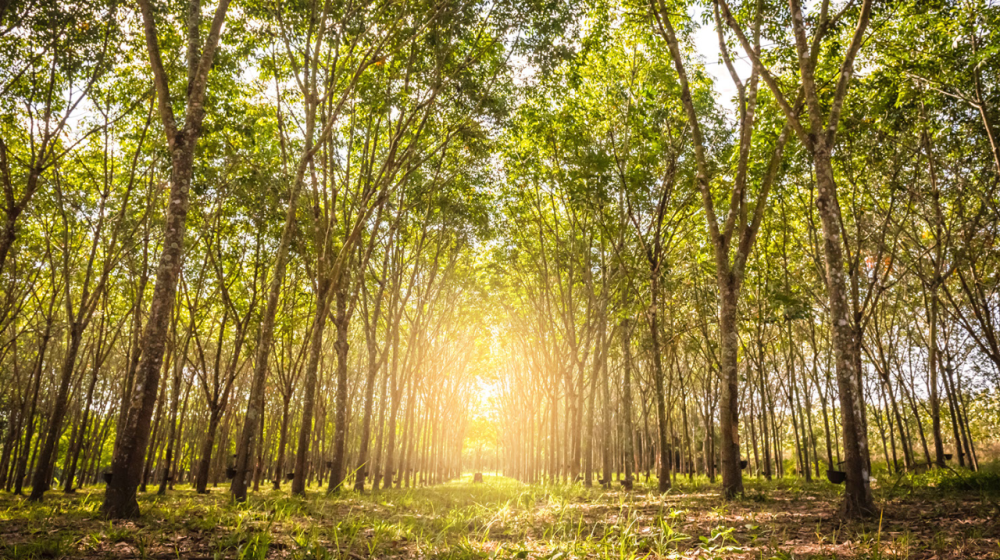
What is natural rubber and why should we care? The future of rubber and the case for innovation in the tire industry.
The Individual Producer Responsibility (IPR) model used in Ontario is intended, among other things, to spur innovation at the manufacturing level, to drive innovation that reduces waste, and increase the recyclability and re-useability of the products we use in our homes and businesses. The tire industry is embracing this need in several ways, including, the exploration of new tire material options, developing more efficient tires and of course, ensuring that tires are responsibly recycled and repurposed into new products.
To examine this, let’s begin and the beginning. Imagine a world without rubber, without tires, where planes couldn’t land, and cars couldn’t drive…What would happen? Let’s start by exploring the intriguing history of rubber, its contribution to the tire industry, and the inevitable transformation and innovation that is occurring on account of its finite supply.
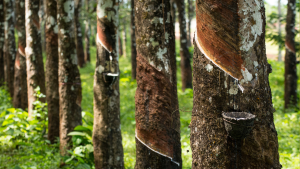
Hevea brasiliensis tree tapping latex
Are tires still made of rubber?
Rubber is a natural product produced from one tree and a handful of plants. It is classified as a polymer. Some polymers exist naturally while others are produced in laboratories and factories. Natural rubber is an essential raw material used in over 40,000 products such as medical devices, surgical gloves, aircraft and car tires, pacifiers, clothes, and toys. The global rubber market size was worth nearly US$41 billion in 2018.
The most common way to make rubber is to extract the rubber-containing latex (a milky white fluid containing proteins, starches and alkaloids) from a very unique tree called the Hevea Brasiliensis.
In addition to its high strength and the capability to be stretched many times without breaking, natural rubber compounds are exceptionally flexible, good electrical insulators, and are resistant to many corrosive substances. The largest end-user of rubber is the automotive parts industry, which uses rubber to make car tires, hoses, pipes, gaskets, and other parts. Nearly 70% of the world’s rubber production is used to make car tires every year. Footwear, led by the top 10 largest footwear companies, is the second largest end-user for rubber.
Synthetic rubber can be produced through a chemical process, but no one has been able to produce a synthetic rubber that has all the properties of natural rubber…yet. Natural rubber is still very important to tire manufacturing, even if tires now contain less rubber than ever before.
Tires carry the great responsibility of supporting tonnes of weight at high speeds across varying terrain, over years of use, all while carrying precious cargo (i.e. humans). The formula that keeps us all safely moving is, therefore, of the utmost importance.

Our tires and cars carry precious cargo
The “seedy” history of the rubber tree and why are we searching for new sources
While liquid rubber was used medicinally as early as 1600 B.C., we credit Christopher Columbus for bringing it to the Americas in the 1490s. South Americans used to dip hats and cloth in latex to make them stronger and waterproof. It wasn’t until Charles Marie de la Condamine went to the Amazon in 1734 and found two trees containing latex. The Castilla Tree and the Hevea Brasiliensis. Ultimately, the Hevea tree succeeded over the Castilla tree because of the way its latex was transported along the trunk. The Hevea tree has connected latex tubes that form a network, or connected system, that bleeds latex when a special incision is made in its trunk making it much easier to harvest.
In 1839 Charles Goodyear invented the vulcanization process of treating rubber with sulfur and heat, to harden it while keeping its elasticity. It prevents rubber from melting in the summer and cracking in the winter. Then in 1888, John Boyd Dunlop invented the air-filled rubber tire, making rubber an extremely important raw material worldwide. Rubber became an essential material for the Industrial Revolution. So much so, it created a huge push from businesses to increase the amount of rubber extracted from Amazonian trees. At the time the Brazilian Amazon was the only source of rubber. They controlled the price, making rubber expensive.
Rubber was such an important material for Brazilians that they prohibited the export of rubber seeds or seedlings. Yet, in 1876, Henry Wickham managed to smuggle 70,000 rubber seeds, hidden in banana leaves, from the Amazon to England. From those seeds, only 1,900 seedlings survived and were sent to Malaysia to start the first rubber plantations in Asia.
After only 12 years, the Malaysian plantations soon became the world’s main natural rubber supplier. In 1888 Henry Nicolas Ridley, a scientist at the Singapore Botanic Gardens, developed a continuous tapping method for harvesting latex from the Heveas. With a much higher yield and a global demand for the product, rubber became an essential material in Singapore’s development.
Nowadays, around 90% of natural rubber is produced in Asia, with Thailand and Indonesia being the most important rubber suppliers (supplying more than 60% of the world’s natural rubber).
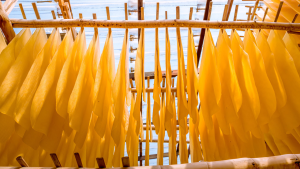
Natural rubber drying in vertical sheets
So why are we looking for new rubber sources?
Since Asian rubber plantations started from only a handful of seeds, all the trees are genetically very similar. Less genetic variation means lower ability to fight against plant diseases. If one tree becomes sick, the illness can rapidly spread to the entire plantation. Under natural conditions, rubber trees commonly grow with a lot of space between them, so disease is less common. On plantations where rubber trees grow very closely together, it can become lethal.
Other threats come from: competition for plantation land from the highly competitive palm oil markets, labour shortages due to the difficult and poorly paid rubber tapping work, the concern that latex from the Hevea tree can cause serious allergy, and the fact that the Hevea trees can only grow in certain tropical climates.
There are a couple of interesting natural rubber alternatives, such as the guayule and Russian dandelion, but the quality of rubber may have more impurities than the Hevea tree, and thus not be good enough for all uses. It is also a more expensive extraction process. The search for more reliable low-cost natural rubber continues.
In the meantime, the automotive industry has made incredible advances in tire construction. Today, only 20-30% of a tire is made of natural rubber. While rubber, steel and fibre make up the bulk of a tire…as many as two hundred different raw materials combine into a unique mix of chemistry, physics and engineering to give consumers the highest degree of comfort, performance, efficiency, reliability and safety that modern technology and creativity can provide.
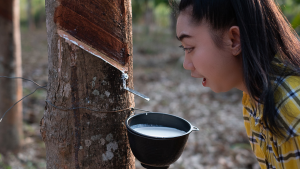
Latex tapped from a hevea brasiliensis tree
In September we’ll look at how tires are made, and the innovations that are making them more sustainable.
As a PRO, eTracks supports producers by managing the flow, recycling and re-purposing of used tires, from source to end point. We manage a complex supply chain of thousands of service providers, like All Ontario Recycling, to ensure producers remain compliant with regulations and support a more circular economy. Interested in how resource recovery, tire recycling and the circular economy works? Visit our resources page.
